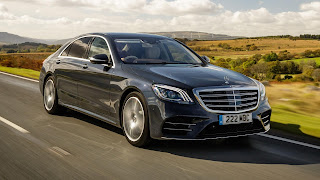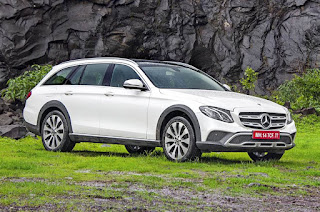A new model designation: the 53 series models.
Mercedes-AMG is extending its product range with the addition of three new models and at the same time introducing a new model designation: the 53 series models of the CLS, E-Class Coupé plus E-Class Cabriolet. They combine powerful performance with sporty style and high efficiency. At their heart lies a new, electrified 3.0-litre engine featuring twin-turbocharging by means of an exhaust gas turbocharger and an electric auxiliary compressor. The 6‑cylinder in-line engine generates 320 kW (435 PS) and delivers a maximum torque of 520 Nm. Its EQ Boost starter-alternator momentarily provides an additional 16 kW of output plus 250 Nm of torque and furthermore feeds the 48 V on-board electrical system. Other technical highlights include the AMG SPEEDSHIFT TCT 9G transmission and the fully variable all-wheel drive system AMG Performance 4MATIC+.
Sporty design, performance and efficiency.
“With the new 53 series models we are extending our portfolio in a first step towards a hybridised future with a leading-edge combination of sporty design, performance and efficiency. The basis for this is a contemporary drive configuration in the form of a six-cylinder in-line engine with electric auxiliary compressor, EQ Boost starter-alternator and 48 V on-board electrical system. “The very spontaneous response to accelerator pedal input, the precision and the design focusing on driving dynamics are hallmark features of AMG. As such we are providing an additional lifestyle-oriented customer group with a further attractive offering from Affalterbach,” explains Tobias Moers, Chairman of the Board of Management of Mercedes-AMG GmbH.
Six-cylinder in-line engine with EQ Boost starter-alternator.
The six-cylinder in-line engine is characterised by top-of-the-range performance and intelligent electrification. The EQ Boost starter-alternator combines a starter motor and alternator in a powerful electric motor and is fitted between the engine and transmission. This innovation as well as the intelligent charging via an electric auxiliary compressor and an exhaust gas turbocharger all have the same goal: to enhance the hallmark AMG performance and driving dynamics, while at the same time reducing fuel consumption and emissions. And this move has been a successful one: the CLS 53 4MATIC+ accelerates from zero to 100 km/h in just 4.5 seconds, and with the Driver's package achieves a top speed of 270 km/h
High torque without lag.
Supported by the EQ Boost starter-alternator when moving off, the electric auxiliary compressor builds up a high charge pressure without any delay, for a faster increase in torque for acceleration until the large exhaust gas turbocharger is deployed. As a result the 3.0-litre engine reacts extremely spontaneously and provides a highly dynamic response without turbo lag. An additional bonus is the high level of refinement of the six-cylinder in-line engine.
Paving the way for hybrid functions.The power for the 48 V on-board electrical system is generated by the EQ Boost starter-alternator. The conventional 12 V network is likewise supplied from the new network – using a DC/DC converter. Thanks to the 48 V battery, the overall battery capacity in the vehicle is increased, enabling more electrical energy to be made available – and therefore also allowing innovative functions to be introduced, for example.
The 48 V on-board electrical system is therefore paving the way for further hybridisation. An additional advantage: the same power requires only a quarter of the current of a conventional system. The result is that the wiring can be thinner and therefore lighter, which indirectly contributes to saving fuel. The existing 12 V system supplies power to consumers such as lights, cockpit, infotainment displays and control units.
xterior: twin-blade radiator grille.
Visually, too, the new 53 series models have a unique look. A distinctive feature common to the models is the twin-blade radiator grille in silver chrome, previously reserved for the V8 Performance models. Instead of the diamond radiator grille with individual pins, the grille in front of the central radiator now features a black lattice pattern.
When viewed from the rear, it is not just the redesigned rear apron that stands out, but also the classic, round twin tailpipe trim elements in high-gloss chrome. The design of the sides of the mud flaps improves the aerodynamics at the rear: as a result this provides for better air flow around the wheel arches. The spoiler lip on the boot lid is painted in the body colour, but is optionally also available in carbon-fibre.
EQ Boost starter-alternator.
The EQ Boost starter-alternator is a key component of the 48 V system and not only serves as an alternator, but is also responsible for hybrid functions. The hybrid functions include boost with 16 kW of output and 250 Nm of torque, recuperation, shifting of the load point, gliding mode and the virtually imperceptible restarting of the engine with the start/stop function.
Because the belt drive for ancillary components on the front edge of the engine is omitted, the installation length of the new six-cylinder engine is also significantly reduced compared with conventional six-cylinder engines. This creates space for an exhaust gas aftertreatment system mounted near the engine, which is therefore particularly efficient. The standard-fit particulate filter is the only part of the exhaust system that is under the floor.
nterior with innovative display concept and operating system.
The interior of the new AMG models welcomes passengers with model-specific, exclusive appointments, luxurious materials and significantly extended options. On top of this there is the innovative control and display concept with bright, high-resolution displays optionally with 12.3-inch screen in each case. Visually, the two displays under one shared glass cover blend into a Widescreen Cockpit and as a central element consequently emphasise the horizontal orientation of the interior design.
The synthesis of exclusivity and sportiness is also underscored by the sports seats (featuring an integral seat look in the E 53 4MATIC+ Coupé and Cabriolet) with AMG-specific seat upholstery layout and AMG badge, red seat belts plus trim elements in carbon fibre or glass fibre in matt silver. The interior is rounded off with the new, standard-fit AMG Performance steering wheel in nappa leather with individualisation options such as wood inserts in piano lacquer or DINAMICA microfibre in the grip area.
Exclusive Edition 1 for the CLS 53 4MATIC+.
From the time of market launch, the exclusive Edition 1 will be available for the CLS 53 4MATIC+ which boasts the COPPER ART interior design. Numerous highlights in a fine copper colour help to ensure a particularly high-quality interior atmosphere. The leather upholstery in black nappa also features copper-coloured contrasting topstitching, as do the instrument panel, armrests, centre console, door panels and piping on the floor mats. Trim elements and the centre console in carbon fibre with COPPER ART copper stitching and the Performance steering wheel with Edition badge equally underscore the vehicle’s exceptional position. The luxurious character is furthermore reinforced by the ambient lighting with 64 colours, the Memory and Mirror package and the exclusive IWC analogue clock.
The new 53 series models celebrate their world premiere on 15 January 2018 as part of the American International Auto Show in Detroit/USA.
Exterior: twin-blade radiator grille.
Visually, too, the new 53 series models have a unique look. A distinctive feature common to the models is the twin-blade radiator grille in silver chrome, previously reserved for the V8 Performance models. Instead of the diamond radiator grille with individual pins, the grille in front of the central radiator now features a black lattice pattern.
When viewed from the rear, it is not just the redesigned rear apron that stands out, but also the classic, round twin tailpipe trim elements in high-gloss chrome. The design of the sides of the mud flaps improves the aerodynamics at the rear: as a result this provides for better air flow around the wheel arches. The spoiler lip on the boot lid is painted in the body colour, but is optionally also available in carbon-fibre.




























